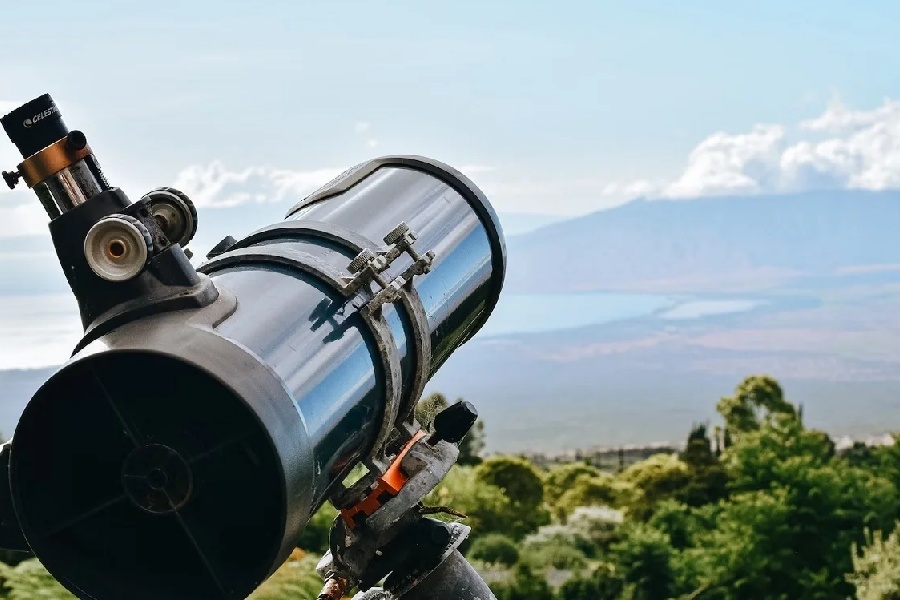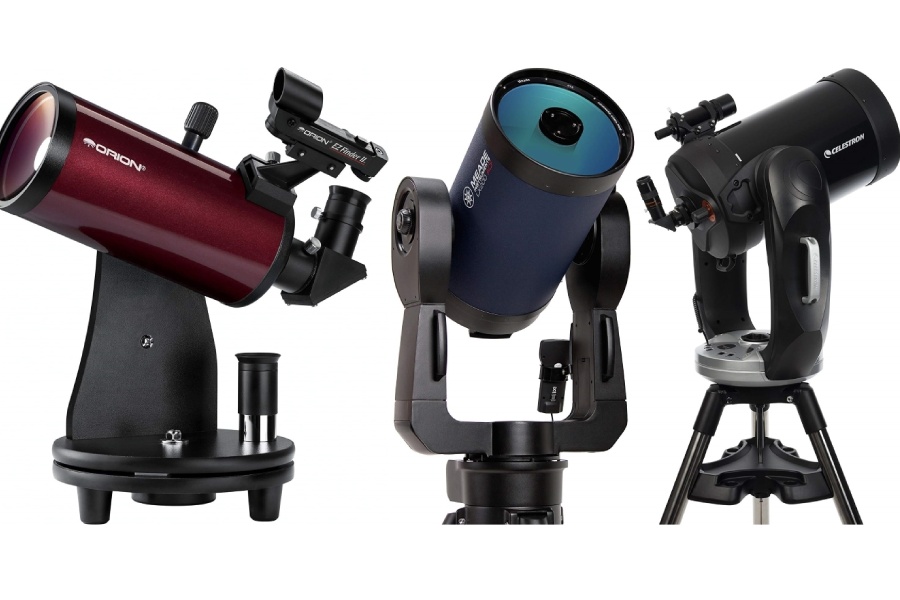For centuries, astronomers peered at the heavens through primitive spy glasses and telescopes. While groundbreaking in their time, early refracting telescopes suffered from a fatal flaw – the bending of light into a rainbow of colors.
Catadioptric telescopes have gained immense popularity among amateur astronomers and astrophotographers in recent years. But what is catadioptric telescope, and what makes it different from regular refracting and reflecting telescopes?
In this article, we will explore the design and components that make up a catadioptric telescope. We’ll learn about the different variations of these telescopes, like the Schmidt-Cassegrain and Maksutov-Cassegrain designs.
We’ll also discuss the advantages and disadvantages of catadioptrics compared to other telescope types. Let us find out how their optical properties allow them to capture crisp, wide-field astrophotography images that were not possible with earlier telescopes.

What Is Catadioptric Telescope?
So, what is catadioptric telescope? It is a compound or hybrid telescope that blends lenses and mirrors for a compact design with enhanced optical performance.
The term “catadioptric” combines “catoptric” (mirrors) and “dioptric” (lenses). This telescope type utilizes a mix of lenses and mirrors to collect and focus light.
The Schmidt-Cassegrain telescope is a common example, featuring a spherical primary mirror at the back that reflects light to a secondary mirror.
The secondary mirror then directs the light through a central hole in the primary mirror to a focal point, accommodating eyepieces or cameras. A corrector plate, typically a thin lens at the front, minimizes optical aberrations.
History of Catadioptric Telescopes
The evolution of catadioptric designs
- Catadioptric telescopes emerged in the early 20th century as astronomers sought to improve image quality over traditional refractive and reflective designs. The pioneering catadioptric telescopes combined both lens and mirror elements.
- In 1905, Henri Chretien first proposed an early design known as the Bouwers-Maksutov telescope, incorporating a spherical primary mirror and correcting lens.
- Bernard Schmidt later refined the catadioptric concept in 1930 with the Schmidt camera, which utilized a specially figured correction plate to remove optical errors.
- In the 1940s, Dmitri Maksutov developed the Maksutov telescope using a deeply curved meniscus corrector lens with a spherical primary mirror.
- Then in the 1960s, Tom Johnson invented the Schmidt-Cassegrain telescope, a compact catadioptric that paired a Schmidt corrector plate with a Cassegrain reflector system.
Key innovations and improvements
Catadioptric telescopes continued improving through the 20th century, with key innovations focused on maximizing image sharpness and resolution. The application of coatings on lens surfaces reduced internal reflections and improved light throughput.
Computer-aided optical design refined corrector elements to minimize aberrations. Exotic mirror materials like beryllium provided stiffer, lighter mirrors that didn’t deform under their own weight.
The development of compact folded optical paths enabled smaller, more portable catadioptric telescopes. Modern manufacturing methods also allowed high-precision figuring of aspheric mirrors for superior image quality.
Contributions to astronomy
Catadioptric telescopes became vital tools for astronomical observation and astrophotography. Their wide fields of view enabled surveys of large swaths of the night sky. Their ability to photograph faint, deep-sky objects accelerated discoveries of galaxies and nebulae.
Their sharp images facilitated detailed observations of planets, stars, comets, and other objects within the Solar System. Catadioptrics provided unique advantages over reflectors or refractors alone by blending lenses and mirrors in one system.
Both professionals at observatories and amateurs in backyard stargazing benefited enormously from the capabilities of catadioptric telescopes. The catadioptric design revolutionized telescope optics and opened new vistas of space research and visual discovery that continue today.
Benefits of a Catadioptric Telescope
Combining optical strengths
Catadioptric telescopes fuse the capabilities of lenses and mirrors into one system, offering significant advantages. Lenses provide wider fields of view compared to mirrors alone. Mirrors eliminate chromatic aberration inherent in refracting telescopes.
Corrector elements counteract optical errors from spherical mirrors. Folded optical paths allow a compact, portable package. Light throughput and image brightness also surpass refractors of equal aperture.
Enhanced imaging performance
The catadioptric design results in telescopes uniquely suited for visual use and astrophotography. Their wide, flat fields are ideal for capturing expansive nebulae, galaxies, and star clusters. Fast focal ratios provide high image resolution with shorter exposure times.
They deliver excellent edge-to-edge sharpness for crisp photos across the entire field. High contrast allows the detection of faint details and structures. Point sources like stars focus on tight, round points even at the edges.
Minimal chromatic aberration provides good color correction. Large apertures in compact packages offer excellent light-gathering ability.
Versatile observing options
Catadioptric telescopes are highly versatile for a range of astronomical pursuits. Their mobility aids are used at dark sky observing sites far from home. Variants with slow focal ratios can track satellites and view terrestrial scenery.
Fast focal ratios suit planets, double stars and lunar/planetary imaging. Large field sizes are ideal for comet seeking and meteor shower watching.
Their excellent optics facilitate research like variable star monitoring. Choices between Schmidt-Cassegrain, Maksutov, and Schmidt camera designs allow tailoring the telescope to specific needs.

Components of a Catadioptric Telescope
Primary mirror
The primary mirror is the large main light-collecting element located at the bottom of the telescope tube. It has a spherical or parabolic concave shape that precisely reflects and focuses incoming light back up the optical tube.
The primary mirror is typically made of low-expansion glass or exotic materials like beryllium and is fingered to an accurate surface shape. Its diameter determines the telescope’s light-gathering ability and maximum resolution.
Secondary mirror
Partway up the optical tube is a small, convex secondary mirror mounted on a transparent lens element or “spider”.
This secondary mirror intercepts the light from the primary mirror and reflects it 90 degrees or more to the side to bring the light to a final focus at the eyepiece or camera.
Corrector plate
A critical component is the corrector plate made of low-expansion glass or fused silica. It has a very shallow conical or aspheric shape that is figured precisely to correct the primary mirror’s aberrations.
The corrector plate is located at the top opening of the telescope tube and minimizes off-axis aberrations like coma and astigmatism.
Refractive elements
Additional lenses may be incorporated into the optical system. Maksutov designs have a strongly curved meniscus lens that helps correct spherical aberration from the spherical primary mirror.
This meniscus element doubles as the transparent mounting for the secondary mirror. Schmidt cameras may have field-flattening lenses near the focal plane to improve sharpness across the large imaging area.
Accessories for a Catadioptric Telescope
Mounts and tripods
A sturdy mount provides critical support for a catadioptric telescope. Equatorial mounts allow smooth tracking of objects as the sky appears to rotate overhead. Computerized mounts can automatically find and track targets with no intervention needed by the user.
Alt-azimuth mounts are simple to use but require manual tracking of celestial objects. Sturdy tripods prevent vibrations that could degrade image sharpness during astrophotography.
Portable mounts are also available for easily transporting the telescope to dark observing sites away from light pollution. For large, heavy instruments, heavy-duty mounts are required to firmly withstand the weight without flexing.
Eyepieces
Eyepieces serve as the window to the telescope for visual observation. Swapping out different focal length eyepieces allows changing the magnification provided by the telescope.
Short focal lengths provide higher power views but limit the width of the field of view. Longer focal lengths offer wider fields of view but at lower magnification.
Consider quality eyepieces with good eye relief for comfortable viewing, sharpness across the entire field, and coatings to maximize light transmission. Most catadioptric telescopes include one or two eyepieces to get started, with the option to add more for versatility.
Filters
Filters allow for enhancing the visibility of particular celestial objects. Moon filters reduce glare and improve observing comfort when viewing the bright moon.
Light pollution filters increase contrast which can reveal more detail in galaxies, nebulae, and star clusters from light-polluted areas. Narrowband filters isolate specific nebula emission lines to boost their brightness.
Polarizing filters decrease atmospheric haze and scatter for sharper long-distance viewing. Color filters help observe subtle surface features on the planets.
Other accessories
A number of additional accessories further expand the capabilities of catadioptric telescopes. Barlow lenses effectively double or triple the magnification for a closer high-power view.
Focal reducers widen the field of view, which is useful for large-scale astrophotography. Dew shields prevent dew buildup on the objective lens or corrector plate. Guiding cameras and accessories enable long-exposure astrophotography by allowing the telescope mount to track objects while imaging.
Computer interfaces allow controlling all functions of the telescope from a laptop computer. The right accessories enable users to customize their catadioptric telescope and truly optimize its performance for their needs.

Conclusion
We hope this article has helped demystify the question of what is catadioptric telescope. By exploring their history, components, benefits, and accessories, we aimed to provide a comprehensive overview of these unique astro-optical instruments.
Catadioptric telescopes merge mirror and lens elements to deliver previously unattainable image quality and versatility, revolutionizing both professional and amateur astronomy.
Their continuing evolution ensures catadioptrics will remain essential tools for visual observation, astrophotography, and pushing the frontiers of space research.
With their array of strengths, catadioptric telescopes look poised to unveil further secrets of the cosmos for years to come. We hope now you have a deeper understanding and appreciation for these innovative telescopes and their inner workings.
